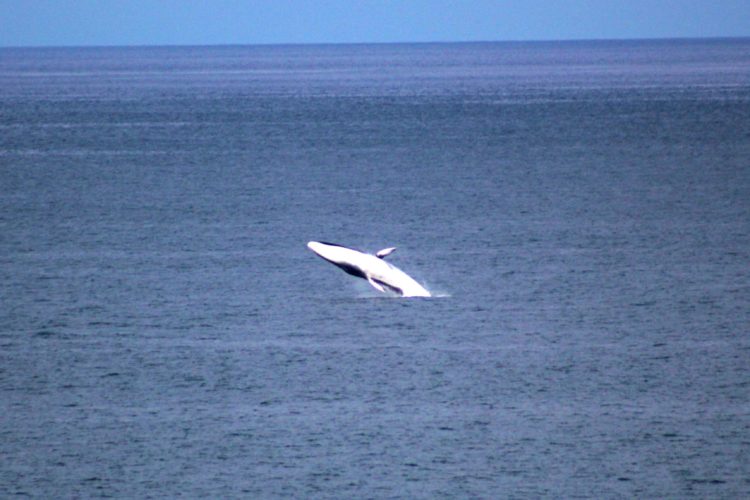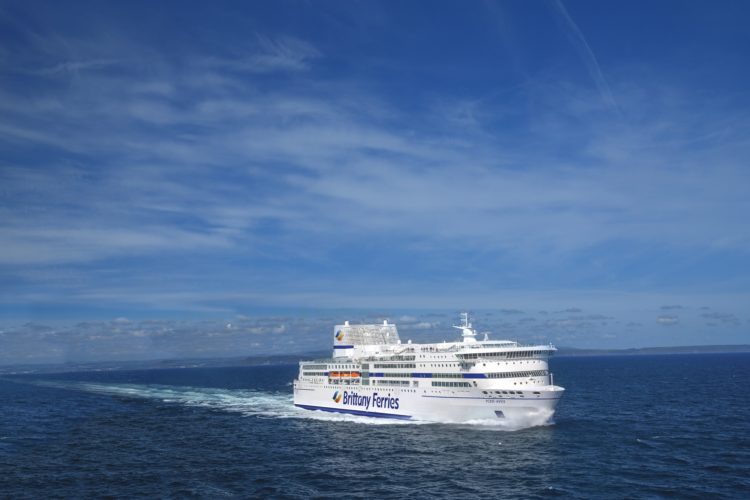One last chance to whale- and dolphin-spot from Plymouth this season
Scientists on-board Brittany Ferries’ Pont-Aven have reported an incredible amount of marine wildlife sightings this summer. And if you live near Plymouth, there’s still one last opportunity to sail on-board and discover these magnificent creatures, with spaces available aboard the company’s last wildlife watching cruise of 2019, departing on 24th September.
Guests will discover and learn about whales and dolphins from wildlife experts from marine conservation charity ORCA, all whilst cruising through some of the world’s most renowned whale watching waters – the Bay of Biscay. A third of all known species of whale and dolphin can be seen in the area. ORCA has been surveying the Bay for many years, so passengers will have the very best experts on hand, making sure that they get the most out of their wildlife experience.
The 2-night mini-cruise will begin in Plymouth, crossing the Bay of Biscay to Santander, the cosmopolitan capital of Cantabria. After a few hours ashore discovering the vibrant Spanish city, guests will re-embark for the return sailing to Plymouth. When not out on deck, there’s still plenty to do with facilities including a range of restaurants serving sumptuous French cuisine, a large boutique selling a wide range of goodies to take home and two cinemas to catch up on the latest releases.
This season has been particularly exciting because ORCA have had the chance to spot more wildlife than ever before in the waters around Plymouth Harbour. Harbour porpoises, minke whales, common dolphins and bottlenose dolphins are amongst the species lucky guests have enjoyed on the picturesque depart from Plymouth during the summer.
Renowned wildlife biologist and broadcaster Lizzie Daly joined one of the Bay of Biscay cruises from Plymouth on 6th August and summed up her experience:
“Weather proof coat and binoculars packed, I was feeling very excited for a serious 48 hours of whale watching. Little did I know I was about to have one of the most thrilling whale watching experiences of my career so far.
“The Bay of Biscay is renowned for being a vast rich feeding ground for a diverse range of cetaceans and so going in I was hopeful of a handful of sightings.
“But can you believe, over the 2 days we spotted a whopping 400+ cetaceans. Whether you’re an avid marine animal enthusiast or not – that’s pretty impressive!
“Sightings included everything from the unmistakable fin whale, pods of 30+ individual pilot whales and even the charismatic Cuvier’s beaked whale. While the long list of cetaceans spotted was an absolute highlight, it wasn’t the only positive from the trip. Over the few days I got to know the ORCA volunteers and members of the public as we shared stories of whale watching past and present, and with each sighting a flurry of excitement would break out on the top deck while everyone worked together to share the position of it.
“I also learnt more about ORCA’s fantastic mapping software which turned each sighting into a crucial scientific data point. This combination – of inspiring and passionate people, a sense of community onboard and the value of Orca’s work – is what made my experience truly unforgettable! After my trip with ORCA I will never look at the ocean in the same way again.”
For more information or to book visit www.brittanyferries.com/whale or call 0330 159 7000. For more information on what ORCA do or how you can help, please visit https://www.orcaweb.org.uk/.
Ends.
About Brittany Ferries
In 1967 a farmer from Finistère in Brittany, Alexis Gourvennec, succeeded in bringing together a variety of organisations from the region to embark on an ambitious project: the aim was to open up the region, to improve its infrastructure and to enrich its people by turning to traditional partners such as Ireland and the UK.
In 1972 BAI (Brittany-England-Ireland) was born. The first cross-Channel link was inaugurated in January 1973, when a converted Israeli tank-carrier called Kerisnel left the port of Roscoff for Plymouth carrying trucks loaded with Breton vegetables such as cauliflowers and artichokes. The story therefore begins on 2 January 1973, 24 hours after Great Britain’s entry into the Common Market (EEC). From these humble beginnings however Brittany Ferries as the company was re-named quickly opened up to passenger transport, then became a tour operator.
Today, Brittany Ferries has established itself as the national leader in French maritime transport: an atypical leader, under private ownership, still owned by a Breton agricultural cooperative. Eighty five percent of the company’s passengers are British. Around 210,000 freight units are carried each year.
Key figures:
Turnover: Approximately €444.2m per year
Employment – Between 2400 and 3100 employees (including 1,700 seafarers), depending on the season. 360 in the UK.
Passengers: Between 2.5 and 2.7 million each year travelling in approximately 900,000 cars
Freight: 205,400 units transported annually, and one freight-only route linking Bilbao and Poole
Twelve ships operating services that connect France, the United Kingdom, Ireland and Spain
Eleven ports in total: Bilbao, Santander, Portsmouth, Poole, Plymouth, Cork, Caen, Cherbourg, Le Havre, Saint-Malo, Roscoff
Tourism in Europe: There were 854,000 unique visitors, staying 9.2 million bed-nights in France.
www.brittanyferriesnewsroom.com.
Contact:
Ellis Malcolm on 02392 892 221 or 07464 980 594 or [email protected]
Christopher Jones on 02392 152 291 or 07917 540 878 or [email protected]
Nigel Wonnacott on 02392 152 273 or 07833 446 729 or [email protected]
 News
News

